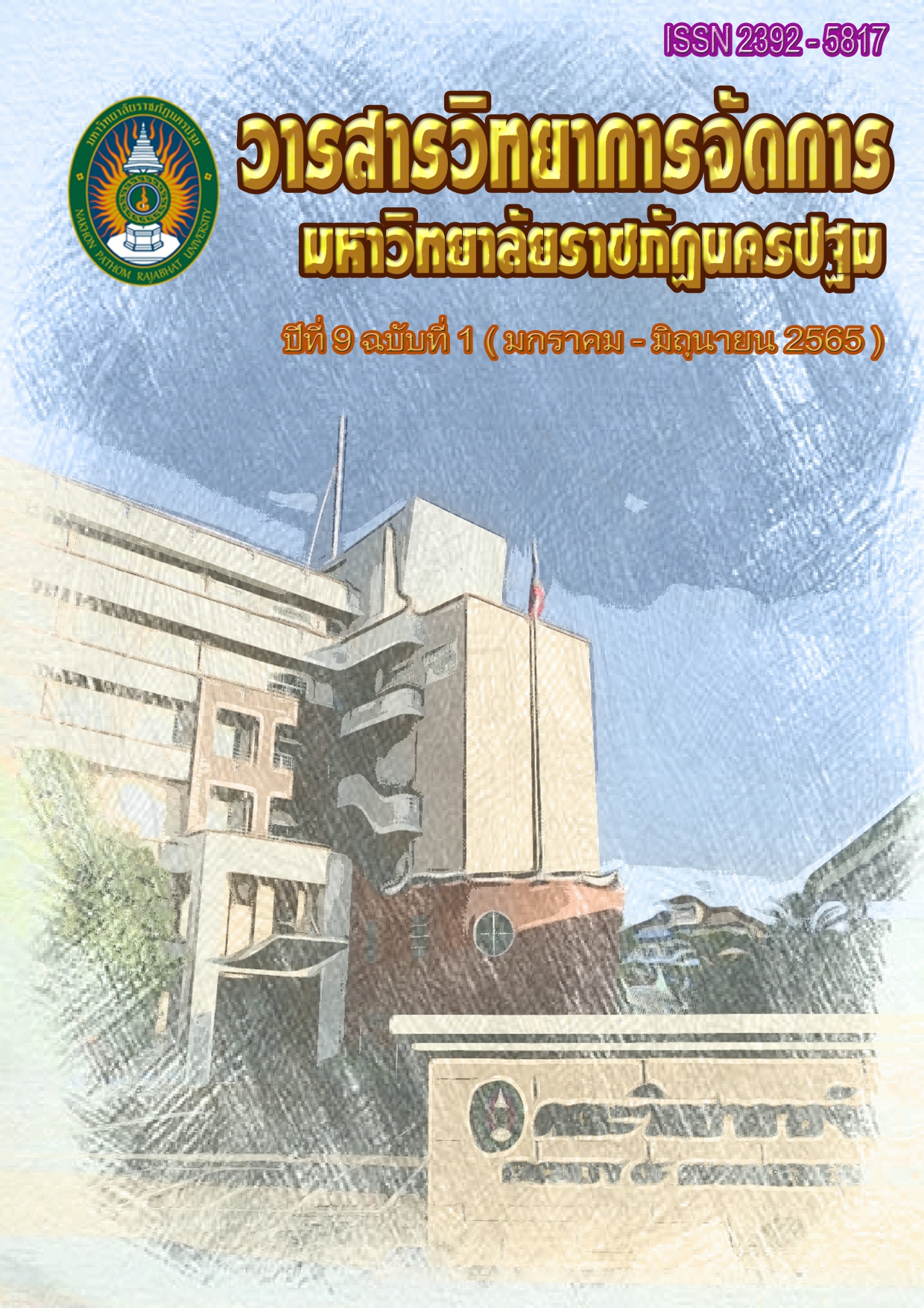การจัดการความสัมพันธ์ร่วมกับคู่ค้าที่ส่งผลต่อ ผลการดำเนินงาน กรณีศึกษา ผู้ประกอบการธุรกิจรถจักรยานยนต์ บิ๊กไบค์ ในนิคมอุตสาหกรรม อมตะซิตี้
Main Article Content
บทคัดย่อ
การวิจัยครั้งนี้เป็นการวิจัยเชิงปริมาณ โดยใช้การวิจัยเชิงสำรวจ มีวัตถุประสงค์ เพื่อศึกษาการจัดการความสัมพันธ์ร่วมกับคู่ค้า ที่มีต่อผลการดำเนินงาน กรณีศึกษา ผู้ประกอบการธุรกิจรถจักรยานยนต์ บิ๊กไบค์ ในนิคมอุตสาหกรรม อมตะซิตี้ จ.ระยอง โดยกลุ่มตัวอย่างในการศึกษาครั้งนี้คือ ผู้ประกอบการธุรกิจรถจักรยานยนต์ บิ๊กไบค์ ในนิคมอุตสาหกรรม อมตะซิตี้ จ.ระยอง จำนวน 50 ราย ซึ่งทางผู้ศึกษาได้ทำการสุ่มตัวอย่าง โดยใช้การสุ่มตัวอย่างแบบเจาะจง โดยทำการส่งแบบสอบถามให้ผู้ส่งมอบปัจจัยการผลิตรายละ 5 แบบสอบถาม รวมเป็น 250 ชุด ซึ่งทำการทดสอบสมมติฐานโดยใช้สถิติ การวิเคราะห์การถดถอยพหุคูณ
ผลการศึกษาพบว่า การจัดการความสัมพันธ์ร่วมกับคู่ค้า ที่ส่งผลต่อ ผลการดำเนินงาน ของผู้ประกอบการธุรกิจรถจักรยานยนต์ บิ๊กไบค์ ด้านกระบวนการภายใน ได้แก่ ปัจจัยการตอบสนองความต้องการ (Beta = 0.323) ปัจจัยด้านการสื่อสาร (Beta = 0.245) และ ปัจจัยด้านความร่วมมือ (Beta = 0.199) ในระดับนัยสำคัญทางสถิติ 0.05 ยังพบอีกว่า การจัดการความสัมพันธ์ร่วมกับคู่ค้า ส่งผลต่อ ผลการดำเนินงาน ของผู้ประกอบการธุรกิจรถจักรยานยนต์ บิ๊กไบค์ ด้านลูกค้า ได้แก่ ปัจจัยด้านการสื่อสาร (Beta = 0.270) ปัจจัยการตอบสนองความต้องการ (Beta = 0.211) และปัจจัยด้านความร่วมมือ (Beta = 0.179) ในระดับนัยสำคัญทางสถิติ 0.05 การจัดการความสัมพันธ์ร่วมกับคู่ค้า ส่งผลต่อ ผลการดำเนินงาน ของผู้ประกอบการธุรกิจรถจักรยานยนต์ บิ๊กไบค์ ด้านการเงิน ได้แก่ ปัจจัยด้านการสื่อสาร (Beta = 0.257) ปัจจัยด้านความร่วมมือ (Beta = 0.208) และปัจจัยการตอบสนองความต้องการ (Beta = 0.182) ในระดับนัยสำคัญทางสถิติ 0.05 การจัดการความสัมพันธ์ร่วมกับคู่ค้า ส่งผลต่อ ผลการดำเนินงาน ของผู้ประกอบการธุรกิจรถจักรยานยนต์ บิ๊กไบค์ ด้านการเรียนรู้และพัฒนา ได้แก่ ปัจจัยด้านการสื่อสาร (Beta = 0.331) และปัจจัยการตอบสนองความต้องการ (Beta = 0.220) ในระดับนัยสำคัญทางสถิติ 0.05
*หลักสูตรการบริหารและพัฒนาอุตสาหกรรม สถาบันวิชาการวิทยาการจัดการ มหาวิทยาลัยเกษตรศาสตร์.20230. การศึกษาค้นคว้าอิสระ ภายใต้การควบคุมของ ดร.เจษฎา วงศ์แสนสุขเจริญ และ ดร.พงศ์พัค บานชื่น
Corresponding author: Suparada_K @gmail.com
Article Details

อนุญาตภายใต้เงื่อนไข Creative Commons Attribution-NonCommercial-NoDerivatives 4.0 International License.
ทัศนะและข้อคิดเห็นของบทความที่ปรากฏในวารสารฉบับนี้เป็นของผู้เขียนแต่ละท่าน ไม่ถือว่าเป็นทัศนะและความรับผิดชอบของกองบรรณาธิการ
เอกสารอ้างอิง
กิรณา แก้วสุ่น และไกรชิต สุตะเมือง. (2559). อิทธิพลของการจัดการความสัมพันธ์กับผู้จัดหาวัตถุดิบที่มีต่อผลการดำเนินการด้านการจัดซื้อจัดหาผักและผลไม้สดในร้านค้าปลีกสมัยใหม่ในประเทศไทย. วารสารวิชาการ RMUTT Global Business and Economics Review, 11(2), 11-22.
ชนิดา พงษ์พานารัตน์. (2554). การพัฒนาและทดสอบความตรงของตัวชี้วัดกระบวนการบริหารโซ่อุปทานในอุตสาหกรรมบริการ. วิทยานิพนธ์ปริญญาบริหารธุรกิจมหาบัณฑิต มหาวิทยาลัยธรรมศาสตร์.
ธีรวุฒิ เอกะกุล. (2543). ระเบียบวิธีวิจัยทางพฤติกรรมศาสตร์และสังคมศาสตร์. อุบลราชธานี: สถาบันราชภัฎอุบลราชธานี.
นพปฎล สุวรรณทรัพย์ และมณฑลี ศาสนนันทน์. (2557). การเพิ่มประสิทธิภาพทางการจัดซื้อด้วยการจัดการความสัมพันธ์กับผู้จําหน่าย กรณีศึกษา อุตสาหกรรมซ่อมบํารุงอากาศยานในประเทศไทย. วารสารวิศวกรรมศาสตร์มหาวิทยาลัยศรีนครินทรวิโรฒ, 9(1), 1-15.
บุณฑรี จันทร์กลับ และชลินธร ธานีรัตน์. (2558). การวิเคราะห์โซ่อุปทานของดอกมะลิ กรณีศึกษา ตำบลท่าเรือ อำเภอเมือง จังหวัดนครศรีธรรมราช. วารสารการวิจัยเพื่อพัฒนาชุมชน (มนุษยศาสตร์และสังคมศาสตร์), 8(1), 91-107.
ศรายุทธ ตรัยศิลานันท์. (2554). ความสัมพันธ์ห่วงโซ่อุปทานระหว่างผู้จัดหาวัตถุดิบกับผู้ซื้อในอุตสาหกรรมอาหารจังหวัดนครราชสีมา. วิทยานิพนธ์ปริญญาการจัดการมหาบัณฑิต สาขาวิชาเทคโนโลยีการจัดการ มหาวิทยาลัยเทคโนโลยีสุรนารี.
สุรสา บุญทา. (2554). การประเมินประสิทธิภาพสายโซ่อุปทานอุตสาหกรรมชิ้นส่วนยานยนต์ในประเทศไทย. วิทยานิพนธ์ปริญญาวิทยาศาสตรมหาบัณฑิต สาขาวิชาการจัดการด้านโลจิสติกส์ (สหสาขาวิชา) จุฬาลงกรณ์มหาวิทยาลัย.
Anderson, J. Narus, J. (1990). A model of distributor firm and manufacturer firm working Partnerships. Journal of Marketing, 54(1), 42-58.
Cambra, J., Polo, Y. (2007). Assessment and reassessment of supply relationships: a case study in the Spanish wine industry. International Journal of Entrepreneurial Behaviour and Research, 13(2), 82-106.
Cannon, J., Homburg, C. (2001). Buyer-supplier relationships and customer firm costs. Journal of Marketing, 65(1), 29-43.
Cannon, J., Perrault, W. (1999). Buyer - seller relationships in business markets. Journal of Marketing Research, 36(4), 439-460.
Fierro, J.C., Redondo, Y.P. (2008). Creating satisfaction in the demand-supply chain: the buyers perspective. Supply Chain Management: An International Journal, 13(3), 211 – 224.
Ganesan, S. (1994). Determinants of long-term orientation in buyer-seller relationships. Journal of Marketing, 58(2), 1-18.
Heffernan, T. (2004). Trust formation in cross-cultural business-to-business relationships. Qualitative Market Research: An International Journal, 7(2), 114 – 125.
Kaplan, R. S. and D. P. Norton. 1996. Using the Balanced Scorecard as a Strategy Management System. Harvard Business Review, 74 (1): 75–85.
Lambert, D.M. Garcia-Dastugue, S.J., & Croxton, K.L. (2005). An Evaluation of Process Oriented Supply Chain Management Frameworks, Journal of Business Logistics, 26(1), 25-51.
Mohr, J., Fischer, R., Nevin, J. (1996). Collaborative Communication in Interfirm Relationships: Moderating Effects of Integration and Control. Journal of Marketing, 60(3), 103-115.
Parsons, A. (2002). What determines buyer-seller relation ship quality. An investigation from the buyer's perspective. The Journal of Supply Chain Management, 38(2), 4-12.
Petersen, K., Handfield, R., Ragatz, G. (2005). Supplier integration into new product development: Coordinating product, process, and supply chain design. Journal of Operations Management, 23(3), 371 – 388.
Rao, S.V.R. ; Raju, M.V.L.N. ; Panda, A.K. ; Reddy, M.R., 2006. Sunflower seed meal as a substitute for soybean meal in commercial broiler chicken diets. Br. Poult. Sci., 47 (5): 592-598
Siguaw, J., Simpson, P., Baker, T. (1998). Effects of supplier market orientation on distributor market orientation and the channel relationship: the distributor perspective. Journal of Marketing, 62(3), 99-111.

